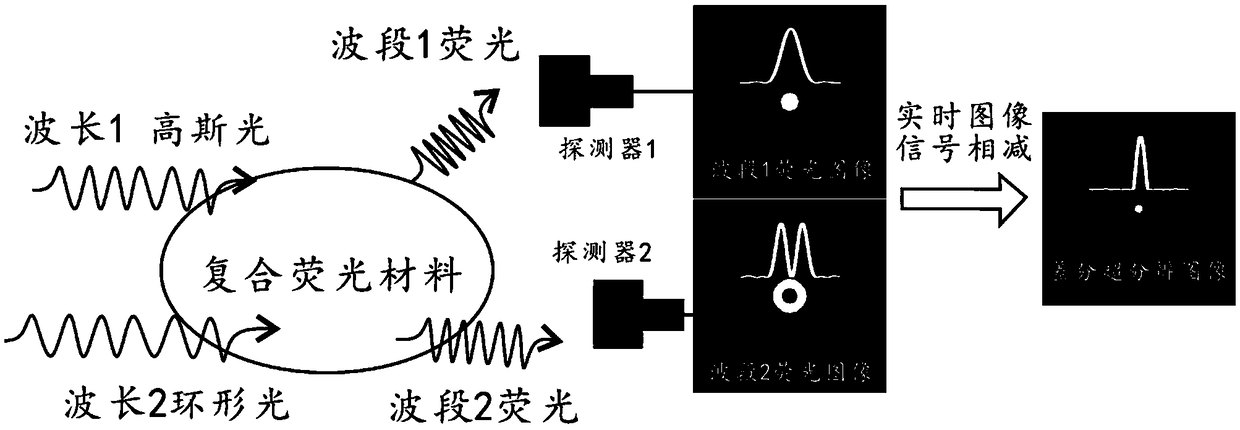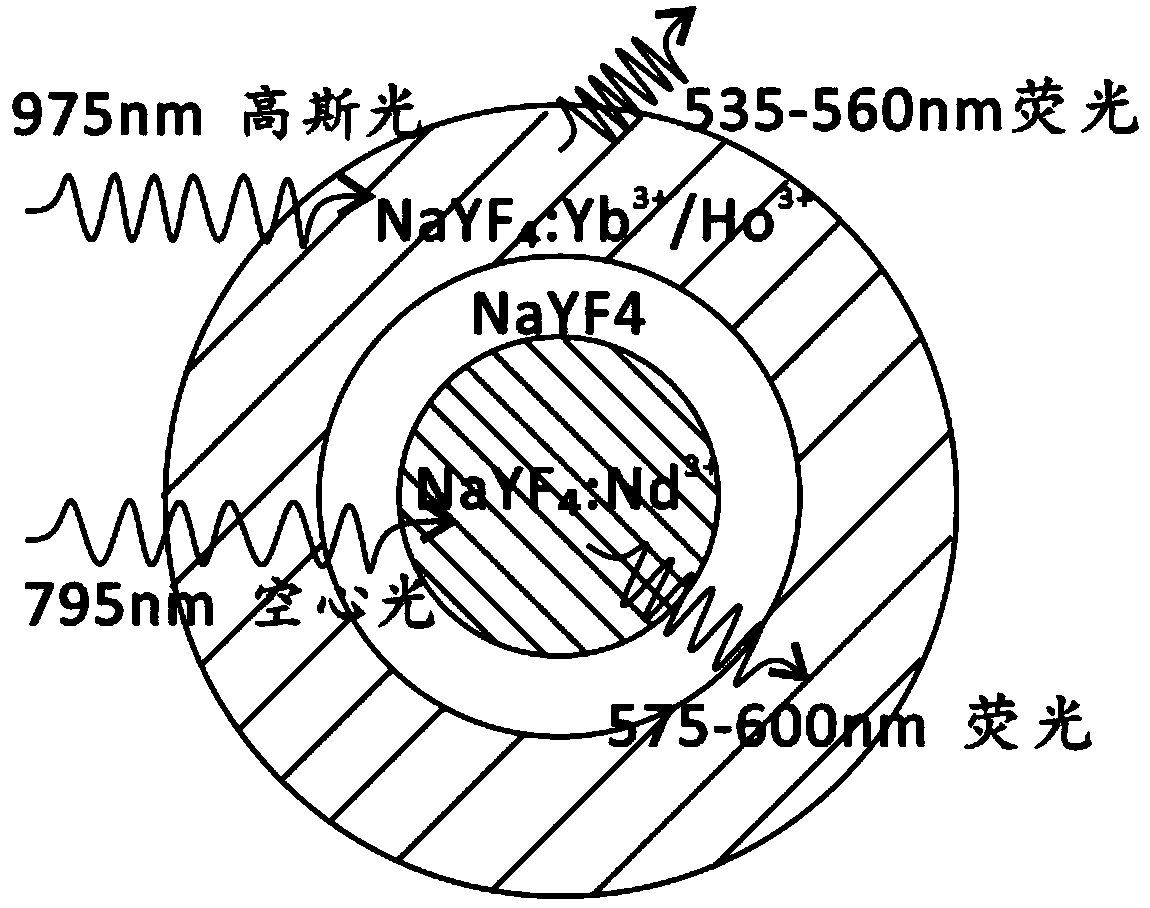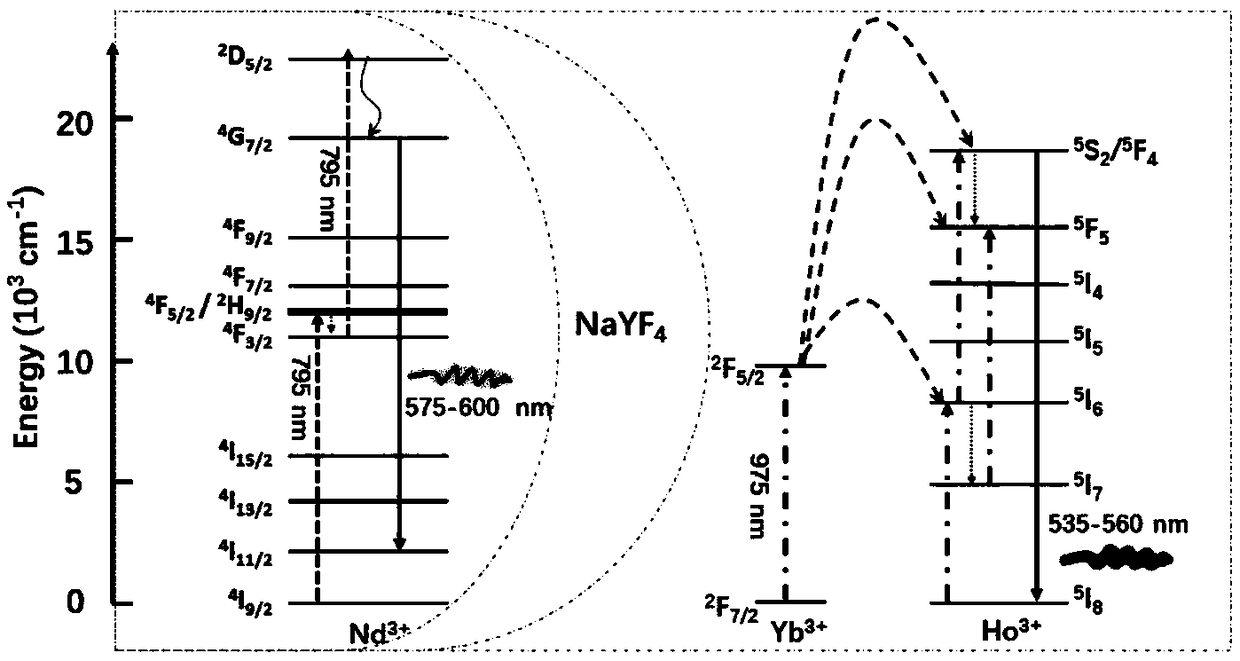Fluorescence imaging method, real-time differential super-resolution microscopic imaging method and device
A fluorescent imaging and microscopic imaging technology, applied in the field of optical microscopy, to achieve the effect of large penetration depth, short life, and small light scattering
- Summary
- Abstract
- Description
- Claims
- Application Information
AI Technical Summary
Problems solved by technology
Method used
Image
Examples
Embodiment 1
[0039] This example illustrates the implementation scheme of synthesizing two kinds of composite up-conversion nanoparticles that emit light independently. build figure 2 The three-layer core-shell structure upconversion nanoparticles NaYF 4 :Nd@NaYF 4 @NaYF 4 :Yb / Ho, able to excite Nd at 795nm 3+ Ion orange fluorescence at 575-600nm and Ho excitation at 975nm 3+ The green fluorescence of ions at 535-560nm, the schematic diagram of the energy level transition of excited fluorescence is as follows image 3 as shown, Figure 4 Fluorescence spectra for 975nm and 795nm laser excitation.
[0040] The specific steps of the material synthesis are as follows:
[0041] (1) Preparation of core NaYF4:Nd (30mol%) upconversion nanoparticles
[0042] In the oleic acid / octadecene system, add 5mL Y(CH3CO2)3 and Nd(CH3CO2)3 solutions with a concentration of 0.2mol / L and a ratio of 7:3, and raise the temperature to 150°C under open conditions for 40-50 minute, lowered to room temperat...
Embodiment 2
[0050] This example clarifies the specific implementation scheme of coupling two fluorescent molecules to composite materials. Taking DAPI coupled to AlexaFluor 568 (hereinafter referred to as AF568) as an example, DAPI can be excited by 405-nm continuous or 810-nm femtosecond laser in the 410-505nm band Fluorescence, AF568 can excite fluorescence in the 570-660nm band by 561-nm continuous or 1022-nm femtosecond laser, which meets the requirements for separation of excitation wavelength and fluorescence wavelength. Correspondingly select a suitable dichromatic mirror, such as Chroma's model 79003bs dichromatic mirror (transmission windows are 455-540nm and 570-660nm, reflection in other wavelength bands), and fluorescence filters can be applied to imaging.
[0051] The concrete implementation process of this composite material preparation is as follows:
[0052] DAPI and AF568 were respectively linked to the ends of the oligonucleotide chains by covalent bonding, and the oligo...
Embodiment 3
[0054] This example clarifies the specific implementation scheme of organic dye-coated upconversion luminescent nanoparticle composite materials, taking Alexa Fluor 532 (hereinafter referred to as: AF532) coated Yb / Tm doped nanoparticles (hereinafter referred to as: UCNP) as an example, AlexaFluor 532 Fluorescence in the 540-600nm band can be excited by a 532-nm continuous or 1064-nm femtosecond laser, and Yb / Tm doped nanoparticles can be excited by a 975-nm continuous laser in a 450-485nm band, meeting the requirements for separation of excitation wavelength and fluorescence wavelength.
[0055] The specific implementation process of composite material preparation is as follows:
[0056] (1) Alexa Fluor 532 (hereinafter referred to as: AF532) modified amino group
[0057] Weigh 0.48g (1mmol) of AF532 and 0.3g of N,N'-dicyclohexylcarboimide (DCC) and dissolve in 15ml of tetrahydrofuran (THF). At room temperature, the mixture was stirred under nitrogen protection for 24 hours....
PUM
 Login to View More
Login to View More Abstract
Description
Claims
Application Information
 Login to View More
Login to View More - R&D
- Intellectual Property
- Life Sciences
- Materials
- Tech Scout
- Unparalleled Data Quality
- Higher Quality Content
- 60% Fewer Hallucinations
Browse by: Latest US Patents, China's latest patents, Technical Efficacy Thesaurus, Application Domain, Technology Topic, Popular Technical Reports.
© 2025 PatSnap. All rights reserved.Legal|Privacy policy|Modern Slavery Act Transparency Statement|Sitemap|About US| Contact US: help@patsnap.com



